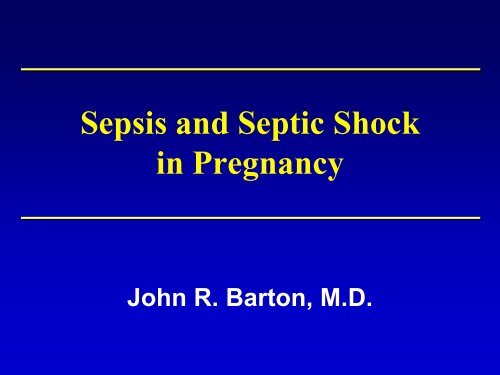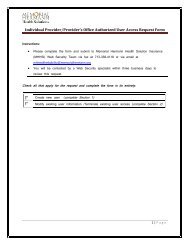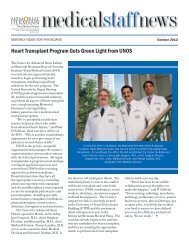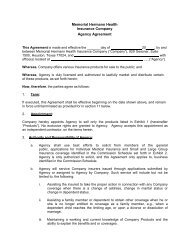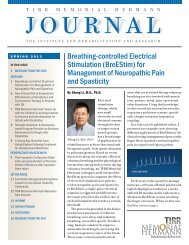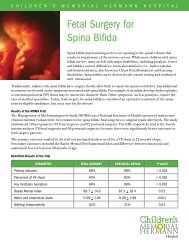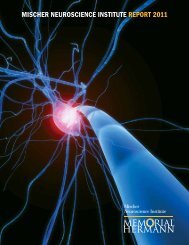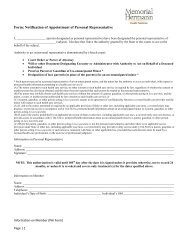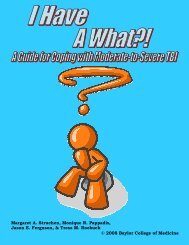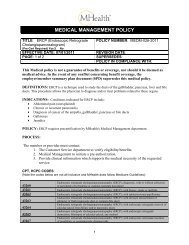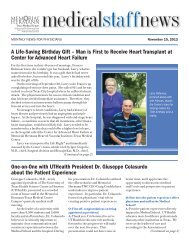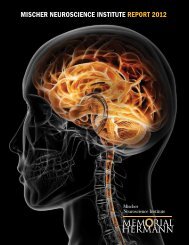Sepsis and Septic Shock in Pregnancy - Children's Memorial ...
Sepsis and Septic Shock in Pregnancy - Children's Memorial ...
Sepsis and Septic Shock in Pregnancy - Children's Memorial ...
- No tags were found...
Create successful ePaper yourself
Turn your PDF publications into a flip-book with our unique Google optimized e-Paper software.
<strong>Sepsis</strong> <strong>and</strong> <strong>Septic</strong> <strong>Shock</strong><strong>in</strong> <strong>Pregnancy</strong>John R. Barton, M.D.
Disclosure of RelevantF<strong>in</strong>ancial RelationshipsResearch support• Alere, San Diego (BIOSITE)• Beckman Coulter(Biomarkers for preeclampsia)Consultation• GTC Biotherapeutics
Cases / 100,000Deaths/YearComparison of <strong>Sepsis</strong> WithOther Major DiseasesIncidence of Severe <strong>Sepsis</strong>Mortality of Severe <strong>Sepsis</strong>300250,000250200,000200150100500AIDS* Colon Breast CHF † SevereCancer § <strong>Sepsis</strong> ‡150,000100,00050,0000AIDS*BreastCancer §AMI †Severe<strong>Sepsis</strong> ‡†National Center for Health Statistics, 2001. § American Cancer Society, 2001. *American Heart Association.2000. ‡Angus DC et al. Crit Care Med. 2001;29(7):1303-1310.
The fundamental cl<strong>in</strong>ical problem of sepsis was readilyapparent even to the casual observer over 500 years ago“Hectic fever (sepsis) at its<strong>in</strong>ception is difficult torecognize but easy to treat.Left untended, it becomes easyto recognize but difficult totreat.”- Circa 1498Steven M. Opal, MDInternational <strong>Sepsis</strong>Forum SymposiumSept. 27, 2007Niccolo MachiavelliThe Pr<strong>in</strong>ce, Book III
Maternal mortality, 1842“It is not by chance that a s<strong>in</strong>gle obstetrician has 16fatal cases <strong>in</strong> a s<strong>in</strong>gle month - I can only dispel thesadness which falls upon me by gaz<strong>in</strong>g <strong>in</strong>to thathappy future when the <strong>in</strong>fection will be banished”Ignaz Semmelweis (1818-1865)1840’s:Ly<strong>in</strong>g-<strong>in</strong> HospitalViennaDivided <strong>in</strong>to two cl<strong>in</strong>icsalternat<strong>in</strong>gadmissionsevery 24 hours:1. First Cl<strong>in</strong>ic: Doctors<strong>and</strong> medical studentsdidautopsies betweendeliveries2. Second Cl<strong>in</strong>ic:Midwives-came <strong>in</strong> offthe street to deliverworegloves outside16141210- Circa 18588642016%First Cl<strong>in</strong>ic7%SecondCl<strong>in</strong>icObserved: Doctors’ h<strong>and</strong>s smelled like corpses(putrefied) but not midwifes; death rate went downwhen students on vacation- no autopsies
Maternal Mortality (%)18161412Maternal Mortality due to Postpartum“purtrefaction”Ly<strong>in</strong>g-<strong>in</strong> Hospital, Vienna, Austria,1841 - 1850Semmelweis’ H<strong>and</strong>Hygiene Intervention10864202 nd cl<strong>in</strong>ic1841 1842 1843 1844 1845 1846 1847 1848 1849 1850H<strong>and</strong> antisepsis reduces the frequency of postpartum sepsis(Hosp Epidemiol Infect Control, 2 nd Edition, 1999)MDs Midwives
The Intervention:H<strong>and</strong> scrub with chlor<strong>in</strong>ated lime solution.Removed the putrefy<strong>in</strong>g smell from the h<strong>and</strong>s ofstudents <strong>and</strong> doctors.H<strong>and</strong> hygiene bas<strong>in</strong> Vienna, 1847What was Semmelweis’s reward <strong>in</strong> 1848 for this major contribution?- Fired by the hospital board for enforc<strong>in</strong>g h<strong>and</strong> wash<strong>in</strong>g requirement for doctors
Systemic Inflammatory ResponseSyndrome (SIRS or SSI)• Inflammatory process– Infection– Non<strong>in</strong>fectious (burns, trauma)• Requires 2 or more of follow<strong>in</strong>g:– Temp > 38 0 C or < 36 0 C– HR > 90 bpm– RR > 20/m<strong>in</strong> or PaCO 2 < 32 mmHg– WBC > 12,000, < 4,000 or > 10% b<strong>and</strong>s• Criteria may differ with physiology of pregnancy– HR >110 bpm, RR >24/m<strong>in</strong>, Temp > 39 0 C– WBC > 15,000
Def<strong>in</strong>itions• <strong>Sepsis</strong>– SIRS due to <strong>in</strong>fection• Severe <strong>Sepsis</strong>– <strong>Sepsis</strong> associated with:• Organ dysfunction• Hypotension• Hypoperfusion– Hypoperfusion abnormalities <strong>in</strong>clude:• Lactic acidosis• Oliguria• Acute alteration <strong>in</strong> mental status
Def<strong>in</strong>itions• <strong>Septic</strong> <strong>Shock</strong>– A subset of severe sepsis– <strong>Sepsis</strong>-<strong>in</strong>duced hypotensionpersist<strong>in</strong>g despite adequate fluidresuscitation– Requirement for vasoactivemedicationsBone et al. Chest 1992
Case History• 31 wks, sore throat, refuses antibiotics– “It might hurt the baby”• Presents 24 hours later– Tachypnea (RR 70 / m<strong>in</strong>)– Tachycardia (HR 140 / m<strong>in</strong>)– Hypotension (SBP 70 mmHg)– Hypoxic (0 2 sat 82%)– Anuria– Febrile (101.2 F)– Ammonia level 98 micro mol / L– IUFD
Case History• Organ dysfunctions– Cardiac Hepatic– Respiratory Hematologic– Gastroenterologic Renal– Neurologic• Intubation, Swan-Ganz, Pacemaker• Dopam<strong>in</strong>e, Dobutam<strong>in</strong>e, Levophed• CPR• Death 8 hrs from admission
Group A StreptococcusThe Etiology, Concept <strong>and</strong> Prophylaxis of Childbed Fever
Case History• Class B IDDM at 37 wks gestation• Previous cesarean section x 1• Maternal weight 200 kg (BMI 65)• TOLAC: 7 cm cx dilatation for 5 hrs– “we wanted to avoid c/s with obesity”• Necrotiz<strong>in</strong>g fasciitis post op day 5• Organ dysfunction– Cardiac– Respiratory– Hematologic– Gastroenterologic– Hepatic– Renal
MicroabscessFascia
Mortality %80Mortality By Number ofOrgan Dysfunctions706076%50403020100One Two Three FourAngus DC,et al, Crit Care Med 2001
Early Goal Directed Therapy• Early provision of time sensitivetherapies (with<strong>in</strong> 6 hrs)• Aggressive hydration• Initiation of antibiotics• If <strong>in</strong>dicated• Vasoactives• Transfusion• InotropesFor flow diagram seeRivers E et al, N Eng J Med 2001
Later Goal Directed Therapy• Complete with<strong>in</strong> 24 hours• Initially recommended– Adm<strong>in</strong>ister “physiologic” steroids– Adm<strong>in</strong>ister drotrecog<strong>in</strong> alpha• WRONG per PROWESS-SHOCK Trial 2011– Tight glucose control (80-110 mg/dl)• WRONG per NICE-SUGAR study 2009<strong>and</strong> VISEP Trial 2008Rivers E et al, N Eng J Med 2001
Mortality (%)The Importance of Early Goal-DirectedTherapy (EGDT) for <strong>Sepsis</strong> Induced HypoperfusionNNT to prevent 1 event (death) = 6 to 860 St<strong>and</strong>ard therapy50EGDT403020100In-hospitalmortality(all patients)28-daymortality60-daymortalityAdapted from Rivers E, Nguyen B, Havstad S, et al. N Engl J Med 2001;345:1368-1377 Table 3, page 1374
<strong>Septic</strong> <strong>Shock</strong> St<strong>and</strong>ard Orders• Your hospital should have them– But do you know where they are?• Central hemodynamic monitor<strong>in</strong>g– CVP, Arterial l<strong>in</strong>e• Involvement of– Pharmacy– Infectious disease specialists– Critical care specialists
Algorithm for <strong>Septic</strong> <strong>Shock</strong> <strong>in</strong> <strong>Pregnancy</strong>Assess airwayAssess breath<strong>in</strong>gIntubation if neededAdm<strong>in</strong>ister oxygenActivate <strong>Septic</strong> <strong>Shock</strong> St<strong>and</strong>ard OrdersStat cultures, labs <strong>and</strong> antibiotics (with<strong>in</strong> 1 st hour)Identify source of <strong>in</strong>fectionInitiate IV fluid bolus20 ml NS/kg over 1 hourAssess volumestatusObta<strong>in</strong> central venous access(CVP, ScvO 2 )Barton, Sibai. Obstet Gynecol 2012
Fluid Resuscitation• Central l<strong>in</strong>e placement• Bolus fluids early <strong>in</strong> resuscitation– Substantial volumes needed (6-10 L NS)• Colloids are not superior to crystalloids• Warm IV fluids• CVP <strong>and</strong> PCWP “normal” do not exist• Physiologic perfusion endpo<strong>in</strong>ts– MAP > 65 mmHg– UOP > 25 ml/hr
Antimicrobial Therapy• Infection prevention• Prompt cultures– Don’t delay therapy– Often (1/3) blood cultures negative• Prompt empiric antibiotic therapy– Survival differences seen <strong>in</strong> delay of therapy ofonly 1 hr• Source control– Debridement of <strong>in</strong>fected tissue– Search for surgically correctable orig<strong>in</strong> <strong>in</strong>fection(abscess, appendicitis, etc.)
Vulvar necrotiz<strong>in</strong>g fasciitis
Post-op C/SMultilocularabscessDisplaced uterus
Lap sponge count correct?
Postpartumnecrotiz<strong>in</strong>gfasciitis
Cultures• Ur<strong>in</strong>e• Endometrium• Wound or episiotomy site• Blood– M<strong>in</strong>imum 2 blood cultures• 1 percutaneous• 1 from each vascular access (>48 hr)• Amniotic fluid• Other (e.g., sputum, dra<strong>in</strong>s)
Empiric Antimicrobial Therapy• Gentamyc<strong>in</strong> 1.5 mg/kg IV, then 1mg/kg IV every 8 hours• Cl<strong>in</strong>damyc<strong>in</strong> 900 mg IV every 8 hours• Penicill<strong>in</strong> 3,000,000 units IV every 4hoursor• Vancomyc<strong>in</strong> 15 mg/kg IV then dos<strong>in</strong>gby pharmacy• Zosyn 4.5 gm IV STAT, then every 6hrsor• Your hospital’s septic protocol
Vasoactive Therapy• “Fill the tank before yousqueeze the pipes”– William C. Mabie, M.D. 1990
Vasoactive Therapy• Indication– Hypoperfusion despite fluid resuscitation– Initial treatment of profound hypotension• Adm<strong>in</strong>istration <strong>and</strong> monitor<strong>in</strong>g– Central venous access– Invasive arterial blood pressure– Pulmonary artery catheter (rarely)• GOAL: Evidence of <strong>in</strong>creased perfusion– Mental status, UOP, Capillary refill• Drug of choice– Not what you might th<strong>in</strong>k
Norep<strong>in</strong>epher<strong>in</strong>e• First l<strong>in</strong>e therapy• Increases MAP– Significant α-mediated vasoconstriction– Mild β-mediated <strong>in</strong>crease <strong>in</strong> stroke volume• Successfully improved hemodynamics<strong>and</strong> O 2 delivery <strong>in</strong> 93% pts (Dopam<strong>in</strong>e31% pts)• Effectively decreases lactate• Improves UOP• Dopam<strong>in</strong>e renal enhanc<strong>in</strong>g effects a myth
Corticosteroids• Treat patients who still requirevasopressors despite fluidreplacement.– Hydrocortisone 200-300 mg/day, for 7days <strong>in</strong> three or four divided doses or bycont<strong>in</strong>uous <strong>in</strong>fusion.• Wean steroid dose if septic shockresolves.• ACTH stimulation test not requiredBone, et al. NEJM 1987; 317-658VA Systemic <strong>Sepsis</strong> Cooperative Study Group. NEJM 1987; 317:659-65
MAP < 50 mmHg?Consider vasopressorsNoMAP 50-65 mmHg orCVP below 8 mmHg?YesNS 500 mLover 30 m<strong>in</strong>utesMAP > 65 mmHg;ur<strong>in</strong>e output > 25 mL/hr?NoRepeat bolus until 30 mL/kgNS IV over 3 hoursYesMAP > 65 mmHg?Norep<strong>in</strong>ephr<strong>in</strong>eVasopress<strong>in</strong>Steroids for refractoryshockNoMAP > 65 mmHg?NoEvaluate need fordeliveryYesObserve need forfurther IV fluidbolusBarton,Sibai2012
Presentation: Temp 103.5, severe flank pa<strong>in</strong>, N <strong>and</strong> VDiagnosis: PyelonephritisTreatment: IV Fluids, Acetam<strong>in</strong>ophen, IV Antibiotics
3 hrs post therapy: Note resolution of tachycardia <strong>and</strong> tachysystole
Ma<strong>in</strong>tenance PhaseAnticipation of complicationsFetal heart rate,uter<strong>in</strong>e activitymonitor<strong>in</strong>gLungprotectiveventilationfor pts withARDSTransfusePRBCHgb < 7.0gm/dlGlucose>180mg/dl,<strong>in</strong>itiate<strong>in</strong>sul<strong>in</strong>Reassessantibiotics,narrowspectrumStress ulcerprophylaxisDVTprophylaxisConsider<strong>in</strong>otropicagentBarton, SibaiObstet Gynecol 2012
Viral Etiologies for <strong>Sepsis</strong> <strong>in</strong> <strong>Pregnancy</strong>Herpes Simplex Hepatitis
H1N1 <strong>in</strong>fluenza-associated ARDS: Bilateral <strong>in</strong>filtrates
Your Text
Indications for surgical <strong>in</strong>tervention <strong>in</strong>Severe sepsis / <strong>Septic</strong> shock• Cholecystitis with bile duct obstruction• Necrotiz<strong>in</strong>g pancreatitis• Per<strong>in</strong>ephric abscess• Acute appendicitis• Obstruct<strong>in</strong>g renal stone• Reta<strong>in</strong>ed products of conception• Uter<strong>in</strong>e microabscess / gas gangrene• Bowel <strong>in</strong>farction• Pelvic abscess• Necrotiz<strong>in</strong>g fasciitis• Infected episiotomy site
• MaternalIndications for Delivery– Intrauter<strong>in</strong>e <strong>in</strong>fection– Development of DIC– Compromised cardiopulmonary function by uter<strong>in</strong>esize <strong>and</strong>/or peritoneal fluid• Compartment syndrome• Multifetal gestation– Severe ARDS/ barotrauma– Cardiopulmonary arrest• Fetal– Fetal demise– Gestational age associated with low neonatalmorbidity / mortality
Obesity Trends*Among U.S. AdultsDon’tmesswithTexas!*BMI >30 BRFSS, 1991, 1996, 2004
Prevention of Surgical Site Infection• Preoperative antibiotics– 1-2 gm cefazol<strong>in</strong>– 1-2 gm cefotetan• Higher dose for obese patients– BMI > 30– Weight >100 kg• Up to 60 m<strong>in</strong> before sk<strong>in</strong> <strong>in</strong>cision– Compared to Ab at cord clamp<strong>in</strong>g– 48% reduction <strong>in</strong> surgical site <strong>in</strong>fection**Kitter et al Obstet Gynecol 2012
Outcome
References• Rivers E, Nguyen B, Havstad S, et al. Earlygoal-directed therapy <strong>in</strong> the treatment ofsevere sepsis <strong>and</strong> septic shock. N Engl J Med2001;345:1368-77.• Dell<strong>in</strong>ger RP et al. Surviv<strong>in</strong>g <strong>Sepsis</strong> Campaignguidel<strong>in</strong>es for management of severe sepsis<strong>and</strong> septic shock. Crit Care Med 2004;32:858-873.• Dell<strong>in</strong>ger RP et al. Surviv<strong>in</strong>g <strong>Sepsis</strong>Campaign: International guidel<strong>in</strong>es formanagement of severe sepsis <strong>and</strong> septicshock: 2008. Crit Care Med 2008;36:296-327.
References• Mabie WC, Barton JR, Sibai BM. <strong>Septic</strong> shock<strong>in</strong> pregnancy. Obstet Gynecol 1997;90:553-61.• Barton JR, Sibai BM. Severe sepsis <strong>and</strong> septicshock <strong>in</strong> pregnancy. Obstet Gynecol 2012:120• Opal SM. A brief history of sepsis: L<strong>and</strong>marks<strong>in</strong> the underst<strong>and</strong><strong>in</strong>g of severe <strong>in</strong>fection <strong>and</strong>sepsis. International <strong>Sepsis</strong> ForumSymposium, Paris France. Sept 27, 2007• Gu<strong>in</strong>n DA, Abel DE, Toml<strong>in</strong>son MW. Early goaldirected therapy for sepsis dur<strong>in</strong>g pregnancy.Obstet Gynecol Cl<strong>in</strong> North Am 2007;34:459–79.
References• NICE-SUGAR Study Investigators, F<strong>in</strong>fer S,Chittock DR, Su SY, et al. Intensive versusconventional glucose control <strong>in</strong> critically illpatients. N Engl J Med 2009;360:1283-1297.• Critical care <strong>in</strong> pregnancy. ACOG PracticeBullet<strong>in</strong> # 100. Obstet Gynecol 2009;113:443-50.• Bernard GR. Drotrecog<strong>in</strong> alfa (activated)(recomb<strong>in</strong>ant human activated prote<strong>in</strong> C) forthe treatment of severe sepsis. Crit Care Med2003; 31[Suppl.]:S85-S90.• Dell<strong>in</strong>ger RP. Cardiovascular management ofseptic shock. Crit Care Med 2003:946-955.
References• Walsh C, Scaife C, Hopf H. Prevention <strong>and</strong>management of surgical site <strong>in</strong>fections <strong>in</strong>morbidly obese women. Obstet Gynecol2009;113:411-5.• Bone RC, Balk RA, Cerra FB, et al.Def<strong>in</strong>itions for sepsis <strong>and</strong> organ failure <strong>and</strong>guidel<strong>in</strong>es for the use of <strong>in</strong>novative therapies<strong>in</strong> sepsis. Chest 1992;101:1644-55.• Brunkhorst FM, Engel C, Bloos F, et al.Intensive <strong>in</strong>sul<strong>in</strong> therapy <strong>and</strong> pentastarchresuscitation <strong>in</strong> severe sepsis. N Engl J Med2008;358:125-39.
References• DeBacker D, Biston P, Devriendt J, et al.Comparison of dopam<strong>in</strong>e <strong>and</strong> norep<strong>in</strong>ephr<strong>in</strong>e<strong>in</strong> the treatment of shock. N Engl J Med2010;362:779-89.• Perner A, Haase N, Guttormsen AB, et al.Hydroxyethyl starch 130/0.42 versus R<strong>in</strong>ger’sacetate <strong>in</strong> severe sepsis. N Engl J Med2012;367:124-134.• Sprung CL, Annane D, Keh D, et al.Hydrocortisone therapy for patients withseptic shock. N Engl J Med 2008;358:111-24.
References• Kitter ND, McMullen KM, Russo AJ, et al. Longtermeffect of <strong>in</strong>fection prevention practices<strong>and</strong> case mix on cesarean surgical site<strong>in</strong>fections. Obstet Gynecol 2012:120:246-51.• Antimicrobial prophylaxis for cesare<strong>and</strong>elivery: tim<strong>in</strong>g of adm<strong>in</strong>istration. CommitteeOp<strong>in</strong>ion No. 465. ACOG Obstet Gynecol2010:116:791-2.• Use of prophylactic antibiotics <strong>in</strong> labor <strong>and</strong>delivery. Practice Bullet<strong>in</strong> No. 120. ACOGObstet Gynecol 2011:117:1472-83.
Learn<strong>in</strong>g Objectives• Discuss the causes <strong>and</strong> pathophysiologyof sepsis• Discuss goal-directed therapy <strong>in</strong> thetreatment of severe sepsis <strong>and</strong> septicshock• Review <strong>in</strong>dications for surgery ordelivery <strong>in</strong> the sett<strong>in</strong>g of severe sepsis• Review prevention strategies of surgicalsite <strong>in</strong>fection <strong>and</strong> sepsis
Historical Guidel<strong>in</strong>es for <strong>Sepsis</strong> Therapy• Society of Critical Care Medic<strong>in</strong>e (1991)– Def<strong>in</strong>itions of sepsis/septic shock• Society of Critical Care Medic<strong>in</strong>e (1999)– Practice parameters for hemodynamic support ofsepsis <strong>in</strong> adult patients• The Surviv<strong>in</strong>g <strong>Sepsis</strong> Campaign– Phase I (2001) : Goal directed therapy <strong>in</strong> thetreatment of severe sepsis to reduce mortality– Phase II (2004) : Guidel<strong>in</strong>es published formanagement– Phase III (2008): Guidel<strong>in</strong>es translated <strong>in</strong>tocl<strong>in</strong>ical practice
Pro-InflammatoryResponseCompensatory Anti-Inflammatory Response
Probability of SurvivalFluid ResuscitationSevere <strong>Sepsis</strong>R<strong>in</strong>ger’sacetateHES 130 / 0.4Death rateat 90 days43% R<strong>in</strong>ger’s51% HES 130Days s<strong>in</strong>ce r<strong>and</strong>omizationPerner, et alNEJM 2012
"Except on few occasions,the patient appears to die fromthe body's response to <strong>in</strong>fection rather thanfrom it."Circa 1904Sir William Osler<strong>in</strong>“The Evolution of Modern Medic<strong>in</strong>e”-1904
Drotrecog<strong>in</strong> Alfa (Xigris)• Decreases microvascular thrombosis• Decreases duration of hypotension• BUT– Increases risk of fatal bleed<strong>in</strong>g (1.5-5%)– Very expensive• * FDA market withdrawal (10/25/2011)– PROWESS-SHOCK trial– Failure to show survival benefit
<strong>Septic</strong> <strong>Shock</strong> <strong>in</strong> <strong>Pregnancy</strong>• Case series of 18 patients– 13 survivors– 5 non-survivors• Causes of shock– Pyelonephritis (n = 6)– Chorioamnionitis (n = 3)– Postpartum endometritis (n = 2)– Toxic shock (n = 2)Mabie W, Barton J, Sibai B. Obstet Gynecol 1997
VentricularFunctionGroup INormalGroup IIMildlyDepressedGroup IIIMarkedlyDepressedMabie et al1997
Dopam<strong>in</strong>e• Renal enhanc<strong>in</strong>g effects are a myth• 1st l<strong>in</strong>e use <strong>in</strong> sepsis <strong>in</strong>creases death– Tachyarrythmias– CNS effect• Use <strong>in</strong> sepsis <strong>in</strong>creases cost– Increased sedation requirements– Increase ventilator duration– Increased ICU <strong>and</strong> hospital LOS
Varicella-Zoster<strong>in</strong> <strong>Pregnancy</strong>
Predispos<strong>in</strong>g Factors for SurgicalSite Infection <strong>in</strong> Obese Women• Tissue hypoxia– Decreased vascularity of SQ fat– Higher risk of hypoxemia• Increased risk of hematoma / seroma• Persistent sk<strong>in</strong> moisture• Decreased tissue antibiotic levels• Increased prevalence of diabetes• Difficult exposure– Longer operative time– Trauma from retractorsWalsh et al, Obstet Gynecol 2009
BACKGROUNDGlobal• Puerperal sepsis– 75,000 maternal deaths / year• Puerperal <strong>in</strong>fections– 16 % of maternal deaths– 5-10 % of maternal morbidity


